52 DKT Questions of Intersections
Note: If you wish to check whether you have master these questions, you may
proceed to
Take a Practice Test now with only questions from this DKT topic.
If you do not have an account yet,
Sign Up one now, it is
FREE!
# 1. If a STOP or GIVE WAY sign has been knocked down, for example, as the result of an accident,
does the line marked across the road have any meaning?
A. Yes, it has the same meaning as the sign itself.B. No, but you must give way if turning.C. No, you only need to give way to the vehicle on your right.
Explanation : IN005 - Intersections
# 2. If both vehicles P and O in the diagram are turning right, which vehicle is in the best position to turn left into the street marked 'X'?
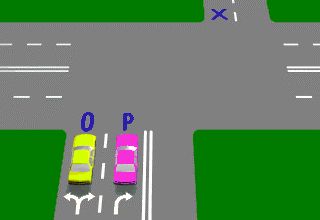 A. Vehicle O.B. Neither vehicle.C. Vehicle P.
A. Vehicle O.B. Neither vehicle.C. Vehicle P.
Explanation : IN012 - Intersections
# 3. You are in car A and want to turn right at this intersection. Car B facing you is also indicating to
turn right. What path should you take?
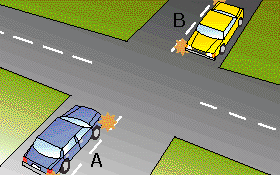 A. Pass behind each other.B. Both pass in front of each other.C. Choose either depending on the traffic.
A. Pass behind each other.B. Both pass in front of each other.C. Choose either depending on the traffic.
Explanation : IN049 - Intersections
# 4. You are driving the car in the diagram. You must stop -
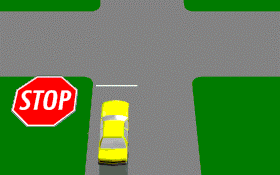 A. Only if there is a car on your right or left.B. Even when there is no other traffic.C. Only if there is danger of a collision with another vehicle.
A. Only if there is a car on your right or left.B. Even when there is no other traffic.C. Only if there is danger of a collision with another vehicle.
Explanation : IN027 - Intersections
# 5. In this diagram both vehicles O and P must pass through GIVE WAY signs before entering the intersection -
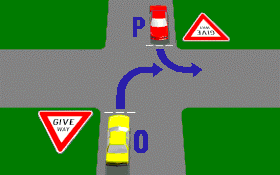 A. It depends on who moves first.B. Vehicle P goes first.C. Vehicle O goes first.
A. It depends on who moves first.B. Vehicle P goes first.C. Vehicle O goes first.
Explanation : IN010 - Intersections
# 6. The traffic on the other side of this intersection has stopped. You are in the car shown and want to cross the intersection. The lights are green. What should you do?
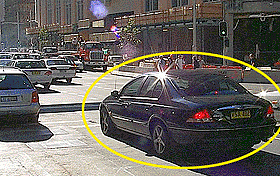 A. Drive into the intersection and then turn left.B. Wait until there is enough room for your vehicle to cross the intersection completely.C. Drive through the intersection slowly and hope that it will clear before the lights change.
A. Drive into the intersection and then turn left.B. Wait until there is enough room for your vehicle to cross the intersection completely.C. Drive through the intersection slowly and hope that it will clear before the lights change.
Explanation : IN038 - Intersections
# 7. You are in the right hand lane and are planning to go straight ahead through this roundabout.
When should you signal left to exit the roundabout?
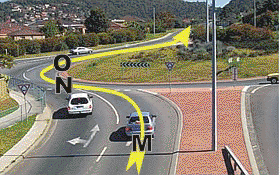 A. After point M.B. After point N.C. After point O.
A. After point M.B. After point N.C. After point O.
Explanation : IN057 - Intersections
# 8. At this intersection there are no signs or traffic lights. You are in the car marked A. You want to
turn left. What should you do?
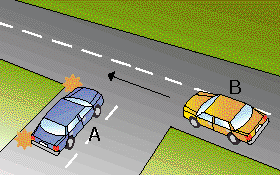 A. Sound the horn to warn the other driver.B. Slow down and give way to car B on your right.C. Enter the intersection and make the turn.
A. Sound the horn to warn the other driver.B. Slow down and give way to car B on your right.C. Enter the intersection and make the turn.
Explanation : IN048 - Intersections
# 9. When police officers are at intersections giving directions you must -
A. Drive through the intersection as you normally would.B. Always follow any instruction they give you.C. Wait for the traffic lights to start working again.
Explanation : IN051 - Intersections
# 10. There are no traffic signs or signals at an intersection. If you intend to drive through the intersection, you must give way to -
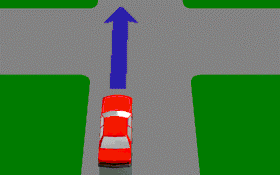 A. Vehicles on your left only.B. Vehicles on your right.C. An oncoming vehicle about to turn right.
A. Vehicles on your left only.B. Vehicles on your right.C. An oncoming vehicle about to turn right.
Explanation : IN002 - Intersections
# 11. When turning left at a roundabout you should enter and leave the roundabout -
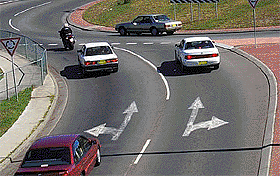 A. In the left lane.B. In the lane with least traffic.C. In the right lane.
A. In the left lane.B. In the lane with least traffic.C. In the right lane.
Explanation : IN062 - Intersections
# 12. When you wish to drive straight ahead at a roundabout you may enter from either the left or right
lane. As you continue around you should -
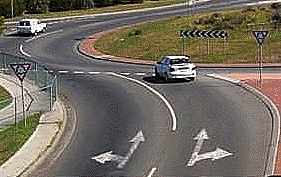 A. Change lanes to get through quickly.B. Move into another lane with least traffic.C. Keep in the lane you entered the roundabout.
A. Change lanes to get through quickly.B. Move into another lane with least traffic.C. Keep in the lane you entered the roundabout.
Explanation : IN061 - Intersections
# 13. You want to turn left at this roundabout. Which lane must you use?
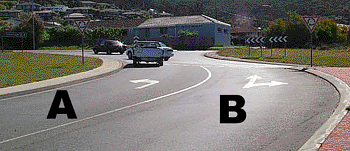 A. Lane A.B. Lane B.C. Either lane.
A. Lane A.B. Lane B.C. Either lane.
Explanation : IN060 - Intersections
# 14. You come to an intersection in Sydney with a Light Rail vehicle about to enter. What should you do?
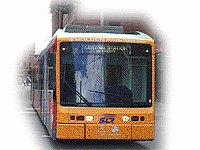 A. Wait until the intersection is clear.B. Enter the intersection, but keep away from the Light Rail vehicle.C. Change lanes before crossing the intersection.
A. Wait until the intersection is clear.B. Enter the intersection, but keep away from the Light Rail vehicle.C. Change lanes before crossing the intersection.
Explanation : IN034 - Intersections
# 15. You drive up to an intersection with a stop sign in the car marked A and you wish to turn right. The car marked B facing you also has a stop sign and is indicating to turn left. Who can go first?
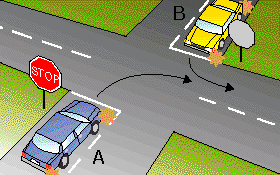 A. Car A.B. Whoever arrives at the intersection first.C. Car B.
A. Car A.B. Whoever arrives at the intersection first.C. Car B.
Explanation : IN045 - Intersections
# 16. Right-turns must be made from which lanes when travelling on a laned roadway?
A. The lane carrying the least amount of traffic.B. The far left-hand lane.C. The far right-hand lane or any other lane having an arrow pointing right.
Explanation : IN008 - Intersections
# 17. You are in the car approaching the intersection shown, you should -
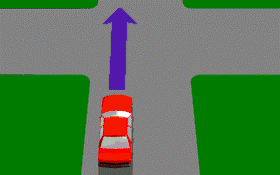 A. Flash your lights to let other vehicles know that you are coming.B. Come to a complete stop before you come to the intersection.C. Drive carefully and approach at a speed which gives you good time to avoid traffic which might suddenly appear.
A. Flash your lights to let other vehicles know that you are coming.B. Come to a complete stop before you come to the intersection.C. Drive carefully and approach at a speed which gives you good time to avoid traffic which might suddenly appear.
Explanation : IN031 - Intersections
# 18. Vehicle O is at a STOP sign -
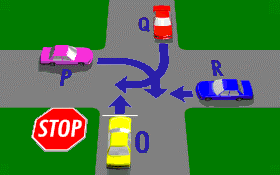 A. All vehicles must give way to vehicle O.B. Vehicle O must give way only to vehicle R.C. Vehicle O must give way to vehicles P, Q and R.
A. All vehicles must give way to vehicle O.B. Vehicle O must give way only to vehicle R.C. Vehicle O must give way to vehicles P, Q and R.
Explanation : IN011 - Intersections
# 19. If turning right at a T-intersection (as shown) must you give way to vehicles approaching from both the left and right?
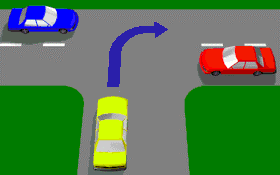 A. No, you have right of way.B. Yes, whether they are turning or not.C. No, only the vehicle on the right.
A. No, you have right of way.B. Yes, whether they are turning or not.C. No, only the vehicle on the right.
Explanation : IN004 - Intersections
# 20. To turn back into the same road from which you joined this roundabout you must -
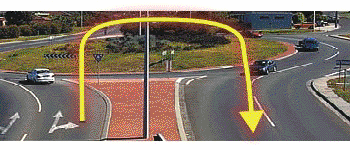 A. Use the left lane all the way round.B. Move into the left lane to leave the roundabout.C. Stay in the right lane all the way round.
A. Use the left lane all the way round.B. Move into the left lane to leave the roundabout.C. Stay in the right lane all the way round.
Explanation : IN065 - Intersections
# 21. You approach an intersection in busy traffic and want to go straight ahead. The traffic lights turn green. When are you permitted to enter the intersection?
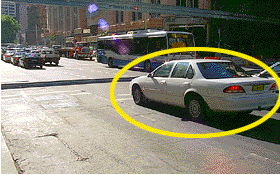 A. When the vehicle behind signals you to go.B. Only when there is room for your vehicle on the other side.C. Immediately after the traffic lights turn green.
A. When the vehicle behind signals you to go.B. Only when there is room for your vehicle on the other side.C. Immediately after the traffic lights turn green.
Explanation : IN035 - Intersections
# 22. You come to an intersection that does not have traffic lights or signs. How do you decide when to
drive straight ahead?
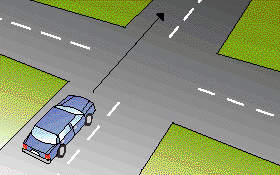 A. Slow down and give way to traffic going into the intersection on your right.B. Wait until all traffic has left the intersection.C. Whoever gets there first can go.
A. Slow down and give way to traffic going into the intersection on your right.B. Wait until all traffic has left the intersection.C. Whoever gets there first can go.
Explanation : IN047 - Intersections
# 23. When making a right-hand turn at the intersection shown, you must give way to -
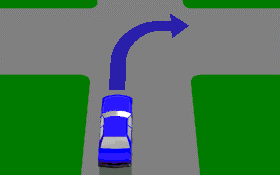 A. An oncoming vehicle going straight ahead or turning left, and any vehicle on your right.B. A vehicle approaching from your left and intending to turn right.C. Only pedestrians.
A. An oncoming vehicle going straight ahead or turning left, and any vehicle on your right.B. A vehicle approaching from your left and intending to turn right.C. Only pedestrians.
Explanation : IN003 - Intersections
# 24. Which vehicle in the diagram must give way?
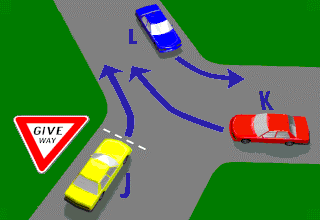 A. Vehicle J.B. Vehicle L.C. Vehicle K.
A. Vehicle J.B. Vehicle L.C. Vehicle K.
Explanation : IN016 - Intersections
# 25. When you wish to turn left at a roundabout you indicate -
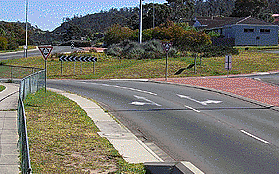 A. Left only after you enter the roundabout.B. Left from start to finish.C. Only if you think it necessary.
A. Left only after you enter the roundabout.B. Left from start to finish.C. Only if you think it necessary.
Explanation : IN058 - Intersections
# 26. You want to make a left turn. You must use your left-hand indicator -
A. Only when arrows are marked on the roadway.B. Only when there is traffic behind you.C. At all times.
Explanation : IN018 - Intersections
# 27. You wish to turn left at this roundabout. Which lane may you use?
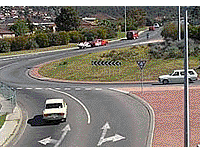 A. Left lane.B. Either lane.C. Right lane.
A. Left lane.B. Either lane.C. Right lane.
Explanation : IN056 - Intersections
# 28. You are at a busy intersection with slow moving traffic and want to go straight ahead. When the
traffic lights change to green you should make sure that -
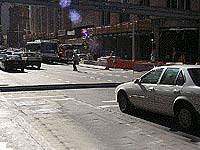 A. You do not hold up the traffic behind you.B. You have the car in the right gear.C. You do not block the intersection.
A. You do not hold up the traffic behind you.B. You have the car in the right gear.C. You do not block the intersection.
Explanation : IN037 - Intersections
# 29. As you drive into an intersection, the lights turn to yellow. You should -
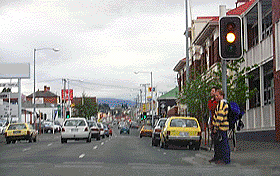 A. Brake immediately to a stop.B. Continue through the intersection.C. Accelerate as hard as you can.
A. Brake immediately to a stop.B. Continue through the intersection.C. Accelerate as hard as you can.
Explanation : IN040 - Intersections
# 30. You wish to turn left here. The pedestrian lights are flashing red. You should -
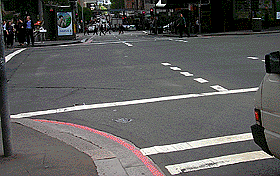 A. Give way to pedestrians still crossing.B. Move into the right hand lane.C. Slowly move through the intersection turning left.
A. Give way to pedestrians still crossing.B. Move into the right hand lane.C. Slowly move through the intersection turning left.
Explanation : IN043 - Intersections
# 31. A GIVE WAY sign at an intersection means that you must -
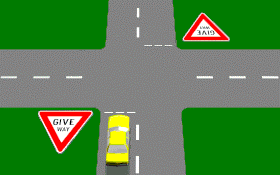 A. Stop completely at all times and have no right of way.B. Be ready to stop and give way to all other traffic if there is danger of a collision.C. Slow down and only give way to traffic on your right.
A. Stop completely at all times and have no right of way.B. Be ready to stop and give way to all other traffic if there is danger of a collision.C. Slow down and only give way to traffic on your right.
Explanation : IN014 - Intersections
# 32. The motorcyclist wants to travel straight ahead through this roundabout. The rider should watch
out for the marked car because the car -
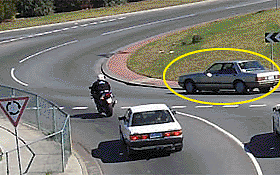 A. Could be going too fast.B. May be leaving the roundabout.C. May stop suddenly.
A. Could be going too fast.B. May be leaving the roundabout.C. May stop suddenly.
Explanation : IN064 - Intersections
# 33. When there are no arrows marked on the road, left turns must be made from -
A. The middle of the road.B. The far left-hand side of the road.C. Either side of the road.
Explanation : IN023 - Intersections
# 34. What should you do on approaching a railway level crossing displaying a STOP sign?
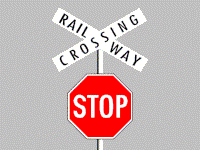 A. Stop at all times and proceed when safe to do so.B. Slow down to 10 km/h, then proceed through the crossing.C. Stop, only if a train is at the crossing.
A. Stop at all times and proceed when safe to do so.B. Slow down to 10 km/h, then proceed through the crossing.C. Stop, only if a train is at the crossing.
Explanation : IN026 - Intersections
# 35. If the boomgates are down and the signals are flashing, at a railway level crossing, you may begin
to cross -
A. If you cannot see a train approaching.B. If you can safely go around the closed gate.C. Only when the gate is up and the lights stop flashing.
Explanation : IN028 - Intersections
# 36. The red car wants to turn right and exit the roundabout in the
street indicated by an arrow. Is the car positioned in the correct
lane to do this?
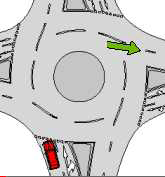 A. Yes, the car can make the turn from either the left hand or the right hand lane.B. No, the car should enter the roundabout only from the right hand lane.C. Yes, the car can make the turn only from this lane.
A. Yes, the car can make the turn from either the left hand or the right hand lane.B. No, the car should enter the roundabout only from the right hand lane.C. Yes, the car can make the turn only from this lane.
Explanation : IN067 - Intersections
# 37. If turning at an intersection are you required to give way to pedestrians?
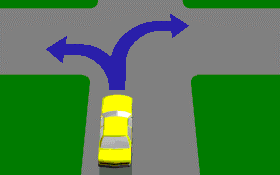 A. Yes, a driver turning right or left must give way to pedestrians, if there is a danger of a collisionB. Yes, only if turning left.C. Yes, only if turning right.
A. Yes, a driver turning right or left must give way to pedestrians, if there is a danger of a collisionB. Yes, only if turning left.C. Yes, only if turning right.
Explanation : IN006 - Intersections
# 38. This intersection does not have any traffic lights or signs. You are in car A and want to turn right. When can you go?
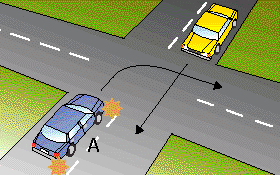 A. After the car going straight ahead has passed.B. As soon as you get to the intersection.C. Before the car going straight ahead has passed.
A. After the car going straight ahead has passed.B. As soon as you get to the intersection.C. Before the car going straight ahead has passed.
Explanation : IN046 - Intersections
# 39. The diagram shows a marked pedestrian crossing at an intersection. There is also a STOP sign at the intersection. You have already stopped for a pedestrian. Must you stop again at the STOP line?
 A. No, if the intersection is clear.B. Yes, at all times.C. Yes, if there is traffic on your right only.
A. No, if the intersection is clear.B. Yes, at all times.C. Yes, if there is traffic on your right only.
Explanation : IN013 - Intersections
# 40. You wish to go straight ahead at this roundabout. Which statement is true?
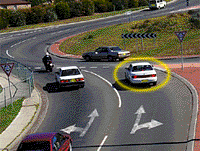 A. You must enter in the right lane and leave in the left.B. You must leave the roundabout in the same lane as you entered.C. You must always leave the roundabout in the left lane.
A. You must enter in the right lane and leave in the left.B. You must leave the roundabout in the same lane as you entered.C. You must always leave the roundabout in the left lane.
Explanation : IN059 - Intersections
# 41. When you come to an intersection and the road beyond is choked with vehicles going in the same
direction, what should you do?
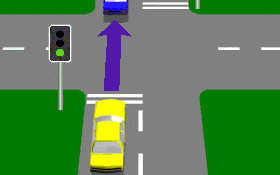 A. Wait until there is room for you to completely cross the intersection.B. Travel into the intersection and wait until traffic ahead moves.C. Proceed if there is no traffic on your right.
A. Wait until there is room for you to completely cross the intersection.B. Travel into the intersection and wait until traffic ahead moves.C. Proceed if there is no traffic on your right.
Explanation : IN007 - Intersections
# 42. You wish to go straight ahead on this roundabout with two lanes. Which lane may you use?
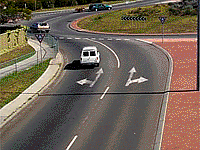 A. Left lane only.B. Either lane.C. Right lane only.
A. Left lane only.B. Either lane.C. Right lane only.
Explanation : IN063 - Intersections
# 43. At the T-intersection shown in the diagram which vehicle should give way?
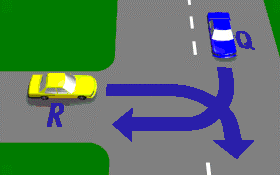 A. Vehicle Q.B. Vehicle R.C. Whichever vehicle got there last.
A. Vehicle Q.B. Vehicle R.C. Whichever vehicle got there last.
Explanation : IN019 - Intersections
# 44. As you approach an intersection, you should check for traffic on your left and right -
A. Only when you approach a stop sign.B. Only when the traffic is heavy.C. At all times before entering the intersection.
Explanation : ININ001 - Intersections
# 45. You drive up to an intersection with a stop sign. There is no painted stop line. Where should you stop?
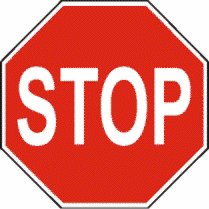 A. Before coming to and as near to the intersection as possible.B. At the point where you can see clearly in both directions.C. At least five metres before the intersection.
A. Before coming to and as near to the intersection as possible.B. At the point where you can see clearly in both directions.C. At least five metres before the intersection.
Explanation : IN044 - Intersections
# 46. You are in car A and are going straight ahead through the intersection. Who should give way?
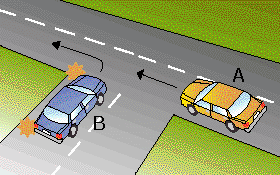 A. Whoever gets to the intersection first.B. Car A.C. Car B.
A. Whoever gets to the intersection first.B. Car A.C. Car B.
Explanation : IN053 - Intersections
# 47. Which statement is correct?
A. Red light cameras take photographs of vehicles that cross intersections when the lights are yellow.B. Red light cameras take photographs of vehicles that speed through intersections.C. Red light cameras take photographs of vehicles that enter intersections when the lights are red.
Explanation : IN039 - Intersections
# 48. You wish to make a right-hand turn from a ONE WAY STREET with no arrows marked on the
roadway. You should position your vehicle -
A. In the middle of the street.B. On the right-hand side of the street.C. On the left-hand side of the street.
Explanation : IN020 - Intersections
# 49. Even if the signal at a railway level crossing does not indicate that a train is coming, you should -
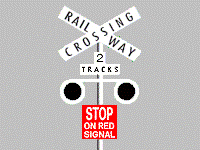 A. Speed up and cross the tracks quickly.B. Stop completely at all times.C. Slow down, be ready to stop and give way if there is danger of collision.
A. Speed up and cross the tracks quickly.B. Stop completely at all times.C. Slow down, be ready to stop and give way if there is danger of collision.
Explanation : IN030 - Intersections
# 50. When approaching a railway level crossing displaying this sign, you must -
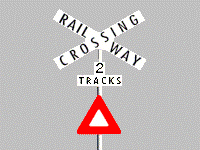 A. Increase your speed to avoid any approaching trains.B. Slow down, look both ways for trains and be prepared to stop if necessary.C. Continue across at normal speed, do not slow down.
A. Increase your speed to avoid any approaching trains.B. Slow down, look both ways for trains and be prepared to stop if necessary.C. Continue across at normal speed, do not slow down.
Explanation : IN029 - Intersections
# 51. When these lights are flashing it means -
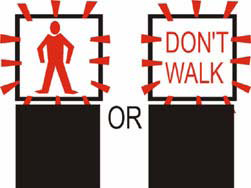 A. Pedestrians are not allowed in this area at this time.B. Pedestrians who have started crossing must go back to the footpath.C. Pedestrians must not start to cross.
A. Pedestrians are not allowed in this area at this time.B. Pedestrians who have started crossing must go back to the footpath.C. Pedestrians must not start to cross.
Explanation : IN042 - Intersections
# 52. In this roundabout with two lanes, can the marked car turn right?
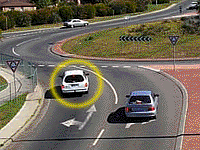 A. No, not at any time.B. Yes, at any time.C. Yes, after changing to the right hand lane.
A. No, not at any time.B. Yes, at any time.C. Yes, after changing to the right hand lane.
Explanation : IN066 - Intersections










































